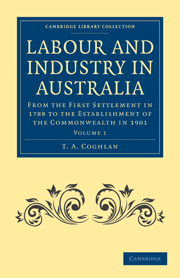 Labour and Industry in Australia
Labour and Industry in Australia Book contents
- Frontmatter
- PREFACE
- Contents
- PART I FROM THE FOUNDATION OF SETTLEMENT TO THE CROSSING OF THE MOUNTAINS
- PART II FROM THE CROSSING OF THE MOUNTAINS TO THE ABOLITION OF THE ASSIGNMENT SYSTEM
- I INTRODUCTION TO THE SECOND PERIOD
- II CONVICT LABOUR: ASSIGNMENT
- III FREE LABOUR
- IV IMMIGRATION
- V THE OCCUPATION OF LAND
- VI AGRICULTURAL AND PASTORAL PURSUITS
- VII THE CURRENCY
- VIII TRADE AND PRICES
- PART III FROM THE ABOLITION OF THE ASSIGNMENT SYSTEM TO THE DISCOVERY OF GOLD
- PART IV FROM THE DISCOVERY OF GOLD TO THE INTRODUCTION OF FREE SELECTION OF LAND BEFORE SURVEY
II - CONVICT LABOUR: ASSIGNMENT
Published online by Cambridge University Press: 05 August 2011
- Frontmatter
- PREFACE
- Contents
- PART I FROM THE FOUNDATION OF SETTLEMENT TO THE CROSSING OF THE MOUNTAINS
- PART II FROM THE CROSSING OF THE MOUNTAINS TO THE ABOLITION OF THE ASSIGNMENT SYSTEM
- I INTRODUCTION TO THE SECOND PERIOD
- II CONVICT LABOUR: ASSIGNMENT
- III FREE LABOUR
- IV IMMIGRATION
- V THE OCCUPATION OF LAND
- VI AGRICULTURAL AND PASTORAL PURSUITS
- VII THE CURRENCY
- VIII TRADE AND PRICES
- PART III FROM THE ABOLITION OF THE ASSIGNMENT SYSTEM TO THE DISCOVERY OF GOLD
- PART IV FROM THE DISCOVERY OF GOLD TO THE INTRODUCTION OF FREE SELECTION OF LAND BEFORE SURVEY
Summary
During this second period the industrial importance of bond labour, as compared with free, was sensibly diminished year by year owing to the influx of voluntary immigrants, although in actual numbers the convict population, including persons on ticket-of-leave, even at the close of the period, exceeded the free adult population, immigrant and emancipist combined. The bond population was divided into three distinct classes much the same as in the previous period: those supported by the Government, those assigned to private employers, and those who, being released on ticket-of-leave, maintained themselves by their own exertions.
The convicts retained by Government were of various grades: the lowest were those sent to a penal settlement or working in the ironed gangs; the next grade were employed in the erection of Government buildings or at work on the Government farms; and the highest grade were the constables, clerks, overseers, and others holding positions which, ordinarily, would have been filled by free persons. The convicts in the penal settlements and in the ironed gangs were, both in New South Wales and Van Diemen's Land, almost without exception persons suffering for offences committed after transportation; occasionally prisoners transported for peculiarly serious and revolting crimes were on their arrival in Australia placed in irons or sent to a penal settlement, but this procedure was of doubtful legality and not often resorted to.
- Type
- Chapter
- Information
- Labour and Industry in AustraliaFrom the First Settlement in 1788 to the Establishment of the Commonwealth in 1901, pp. 173 - 199Publisher: Cambridge University PressPrint publication year: 2011First published in: 1918
